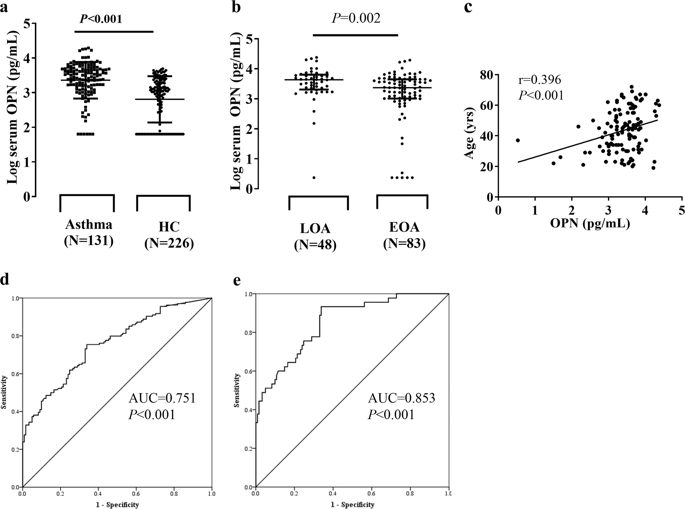当前位置:
X-MOL 学术
›
Exp. Mol. Med.
›
论文详情
Our official English website, www.x-mol.net, welcomes your
feedback! (Note: you will need to create a separate account there.)
Osteopontin contributes to late-onset asthma phenotypes in adult asthma patients.
Experimental & Molecular Medicine ( IF 9.5 ) Pub Date : 2020-02-03 , DOI: 10.1038/s12276-020-0376-2 Hoang Kim Tu Trinh 1, 2 , Thuy Van Thao Nguyen 3 , Seo-Hee Kim 4 , Thi Bich Tra Cao 4 , Quoc Quang Luu 4 , Seung-Hyun Kim 5 , Hae-Sim Park 1, 4
Experimental & Molecular Medicine ( IF 9.5 ) Pub Date : 2020-02-03 , DOI: 10.1038/s12276-020-0376-2 Hoang Kim Tu Trinh 1, 2 , Thuy Van Thao Nguyen 3 , Seo-Hee Kim 4 , Thi Bich Tra Cao 4 , Quoc Quang Luu 4 , Seung-Hyun Kim 5 , Hae-Sim Park 1, 4
Affiliation

|
Patients with late-onset asthma (LOA) have poor clinical outcomes. Osteopontin (OPN) is associated with airway inflammation and remodeling. To investigate the role of OPN in LOA compared to early-onset asthma (EOA), serum OPN levels were compared between 131 adult asthma patients (48 LOA and 83 EOA patients) and 226 healthy controls (HCs). BALB/c mice were sensitized with ovalbumin with/without polyinosinic-polycytidylic acid (poly(I:C)) from week 6 (A6 mice) or week 12 (A12 mice) after birth. Airway hyperresponsiveness (AHR), bronchoalveolar lavage fluid (BALF), cell counts, histology, and Spp1 expression were assessed. The levels of OPN, transforming growth factor β1 (TGF-β1), chitinase 3-like 1 (CH3L1), and interleukin (IL) 5 were measured by ELISA. The expression of Smad3 phosphorylation and tissue transglutaminase 2 (TGM2) was evaluated by Western blot. The serum OPN levels were significantly higher in asthma patients than in HCs and in LOA patients than in those with EOA (P < 0.05) and were positively correlated with serum TGF-β1 and CH3L1 (r = 0.174, r = 0.264; P < 0.05). A12 mice showed elevated AHR with increased levels of OPN/TGF-β1/IL-5 in BALF and Spp1 compared to A6 mice. Poly(I:C) induced remarkable TGF-β1, CH3L1, Th2 cytokine, and OPN levels in BALF and the expression of phosphorylated Smad3, TGM2, and Spp1 in the lungs. OPN triggered TGF-β1/Smad3 signaling in the lungs, which was suppressed by dexamethasone and anti-IL5 antibody. In conclusion, aging and exposure to viral infections may induce OPN release and consequently modulate inflammation and TGF-β1/Smad3-related remodeling, contributing to the development of LOA.
中文翻译:

骨桥蛋白有助于成年哮喘患者的迟发性哮喘表型。
迟发性哮喘(LOA)患者的临床预后较差。骨桥蛋白(OPN)与气道炎症和重塑有关。为了研究OPN在LOA与早期发作性哮喘(EOA)中的作用,比较了131名成年哮喘患者(48名LOA和83名EOA患者)和226名健康对照(HCs)的血清OPN水平。出生后第6周(A6小鼠)或第12周(A12小鼠)用卵清蛋白加/不加肌苷酸-聚胞苷酸(poly(I:C))使BALB / c小鼠致敏。评估气道高反应性(AHR),支气管肺泡灌洗液(BALF),细胞计数,组织学和Spp1表达。通过ELISA测量OPN,转化生长因子β1(TGF-β1),几丁质酶3样1(CH3L1)和白介素(IL)5的水平。通过蛋白质印迹评估Smad3磷酸化和组织转谷氨酰胺酶2(TGM2)的表达。哮喘患者的血清OPN水平显着高于HCs和LOA患者,高于EOA患者(P <0.05),并与血清TGF-β1和CH3L1正相关(r = 0.174,r = 0.264; P <0.05 )。与A6小鼠相比,A12小鼠在BALF和Spp1中的AHR升高,OPN /TGF-β1/ IL-5水平升高。Poly(I:C)在BALF中诱导了显着的TGF-β1,CH3L1,Th2细胞因子和OPN水平以及肺中磷酸化Smad3,TGM2和Spp1的表达。OPN触发了肺中的TGF-β1/ Smad3信号传导,地塞米松和抗IL5抗体抑制了该信号。结论,
更新日期:2020-02-03
中文翻译:

骨桥蛋白有助于成年哮喘患者的迟发性哮喘表型。
迟发性哮喘(LOA)患者的临床预后较差。骨桥蛋白(OPN)与气道炎症和重塑有关。为了研究OPN在LOA与早期发作性哮喘(EOA)中的作用,比较了131名成年哮喘患者(48名LOA和83名EOA患者)和226名健康对照(HCs)的血清OPN水平。出生后第6周(A6小鼠)或第12周(A12小鼠)用卵清蛋白加/不加肌苷酸-聚胞苷酸(poly(I:C))使BALB / c小鼠致敏。评估气道高反应性(AHR),支气管肺泡灌洗液(BALF),细胞计数,组织学和Spp1表达。通过ELISA测量OPN,转化生长因子β1(TGF-β1),几丁质酶3样1(CH3L1)和白介素(IL)5的水平。通过蛋白质印迹评估Smad3磷酸化和组织转谷氨酰胺酶2(TGM2)的表达。哮喘患者的血清OPN水平显着高于HCs和LOA患者,高于EOA患者(P <0.05),并与血清TGF-β1和CH3L1正相关(r = 0.174,r = 0.264; P <0.05 )。与A6小鼠相比,A12小鼠在BALF和Spp1中的AHR升高,OPN /TGF-β1/ IL-5水平升高。Poly(I:C)在BALF中诱导了显着的TGF-β1,CH3L1,Th2细胞因子和OPN水平以及肺中磷酸化Smad3,TGM2和Spp1的表达。OPN触发了肺中的TGF-β1/ Smad3信号传导,地塞米松和抗IL5抗体抑制了该信号。结论,











































 京公网安备 11010802027423号
京公网安备 11010802027423号